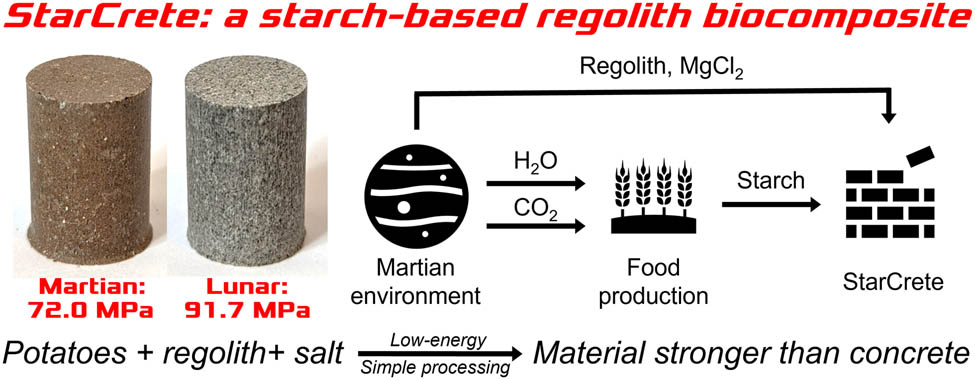
Scientists at the University of Manchester have developed a ‘cosmic concrete’ that could be used to build homes on Mars and present a greener alternative to construction on Earth.
Made from simulated Martian soil, potato starch, and a pinch of salt, ‘StarCrete’ is twice as strong as regular concrete.
Common salt, obtainable from the Martian surface or from the tears of astronauts, can significantly improve its strength, the researchers found.
The cosmic concrete could also offer a greener alternative to traditional concrete for buildings on Earth since it does not require very high firing temperatures or huge amounts of energy to be proecssesed.
Instead, the researchers say it is possible to make StarCrete in an ordinary oven or microwave at normal ‘home baking’ temperatures. This would result in lower emissions and reduced energy costs for production.
Life on Mars?
One of the challenges to human inhabitation of the Moon and Mars is the production high-strength structural materials from on-site resources to provide spacious habitats with adequate radiation shielding.
The production of such materials would ideally be achieved through relatively simple, low-energy processes that support other critical systems.
StarCrete’s research team demonstrated in an article published in Open Engineering that ordinary potato starch can act as a binder when mixed with simulated Mars dust to produce a concrete-like material.
When tested, StarCrete had a compressive strength of 72 Megapascals (MPa), more than twice as strong as the 32MPa of ordinary concrete.
Starcrete made from moon dust was even stronger, at over 91MPa.

The research builds on previous work from the same team that used astronauts’ blood and urine as a binding agent. Although the resulting material was stronger than normal concrete, the process had the drawback of requiring blood on a regular basis – a significant challenge in a space setting.
The team calculated that a 25kg sack of crisps contains enough starch to produce almost half a tonne of StarCrete, which is equivalent to more than 213 brick’s worth of material. A three-bedroom house takes roughly 7,500 bricks to build.
Lead researcher for the project, Dr Aled Roberts, said: “Current building technologies still need many years of development and require considerable energy and additional heavy processing equipment which all adds cost and complexity to a mission.
“StarCrete doesn’t need any of this and so it simplifies the mission and makes it cheaper and more feasible.”
Roberts and his team have recently launched a startup, DeakinBio, that is exploring ways to improve StarCrete so that it could also be used in a terrestrial setting.











